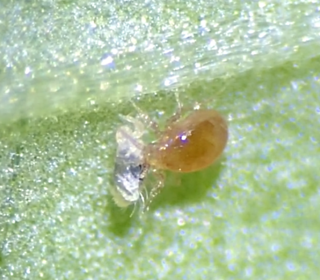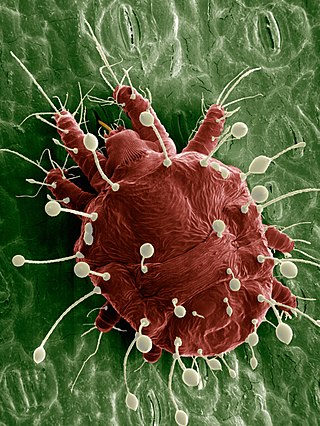
Spider mites are members of the Tetranychidae family, which includes about 1,200 species. They are part of the subclass Acari (mites). Spider mites generally live on the undersides of leaves of plants, where they may spin protective silk webs, and can cause damage by puncturing the plant cells to feed. Spider mites are known to feed on several hundred species of plants.

The Acariformes, also known as the Actinotrichida, are the more diverse of the two superorders of mites. Over 32,000 described species are found in 351 families, with an estimated total of 440,000 to 929,000 species, including undescribed species.

The peacock mites of the genus Tuckerella are a significant herbivorous pest in the tropics, for example on citrus fruit. Other species dwell in grasses, possibly as root feeders.

The Phytoseiidae are a family of mites which feed on thrips and other mite species. They are often used as a biological control agent for managing mite pests. Because of their usefulness as biological control agents, interest in Phytoseiidae has steadily increased over the past century. Public awareness of the biological control potential of invertebrates has been growing, though mainly in the US and Europe. In 1950, there were 34 known species. Today, there are 2,731 documented species organized in 90 genera and three subfamilies.

Tydeidae is a family of acariform mites. As of 2016, it contained over 300 species in three subfamilies, though more species have been discovered since then.

Trombidiidae, also known as red velvet mites, true velvet mites, or rain bugs, are small arachnids found in plant litter and are known for their bright red color.

Raoiella indica, commonly known as the red palm mite, is a species of mite belonging to the family Tenuipalpidae. A pest of several species of palm in the Middle East and South East Asia, it is now becoming established throughout the Caribbean. The invasion of this species is the biggest mite explosion ever observed in the Americas.

Ameroseius is a genus of mites in the family Ameroseiidae. There are more than 60 described species in Ameroseius.
Ameroseius dendrovagans is a species of mite in the family Ameroseiidae.

Brevipalpus phoenicis, also known as the false spider mite, red and black flat mite, and in Australia as the passionvine mite, is a species of mite in the family Tenuipalpidae. This species occurs globally, and is a serious pest to such crops as citrus, tea, papaya, guava and coffee, and can heavily damage numerous other crops. They are unique in having haploid females, a condition caused by a bacterium that change haploid males into females.

Brevipalpus is a genus of mites in the family Tenuipalpidae, the flat mites. The genus includes several species that are among the most important economic pests in the flat mite family.

Schinopsis brasiliensis is a species of flowering plant in the cashew family known by the common names baraúna or braúna.
Acarophenacidae is a family of mites in the order Trombidiformes that are egg parasitoids and ectoparasites of beetles or thrips. It contains eight genera and around 40 species.

Bryobia is a genus of mites in the spider mite family, Tetranychidae. The taxonomy of the genus is difficult. The genus has been revised several times. It is difficult to distinguish these tiny species from each other on the basis of morphological characters, and there is little agreement on which characteristics are of importance. Also, species can be variable in morphology. Over 130 species have been described, but many of the names are likely synonyms.
Citrus leprosis(CL) is an economically important viral disease affecting citrus crops. This emerging disease is widely distributed in South and Central America, from Argentina to Mexico. The disease is associated with up to three different non-systemic viruses, which cause similar symptoms in the citrus hosts and are transmitted by the same vector, mites of the genus Brevipalpus; although they have vastly different genomes. Citrus leprosis virus nuclear type (CiLV-N) is found in the nuclei and cytoplasm of infected cells, while Citrus leprosis virus cytoplasmic type (CiLV-C) is found in the endoplasmic reticulum. In 2012, a new virus causing similar symptoms was found in Colombia and it was named Citrus leprosis virus cytoplasmic type 2 (CiLV-C2) due to its close similarity to CiLV-C. The cytoplasmic type viruses are the most prevalent and widely distributed of the three species.
Neumania papillator is a water mite in the genus Neumania and is known in behavioural ecology as an example of sensory exploitation - males of this species hijack existing female sensory abilities for their own gain in courtship.

Winterschmidtiidae is a family of mites in the order Astigmata.

Stigmaeidae is a family of prostigmatan mites in the order Trombidiformes. At over 600 species, it is the largest family in superfamily Raphignathoidea. It has a worldwide distribution.

Neotrombidium is a genus of velvet mites and chiggers in the family Neotrombidiidae. There are at least three described species in Neotrombidium.

Tetranychoidea is a superfamily of mites in the order Trombidiformes. There are about 5 families and more than 2,200 described species in Tetranychoidea.
















